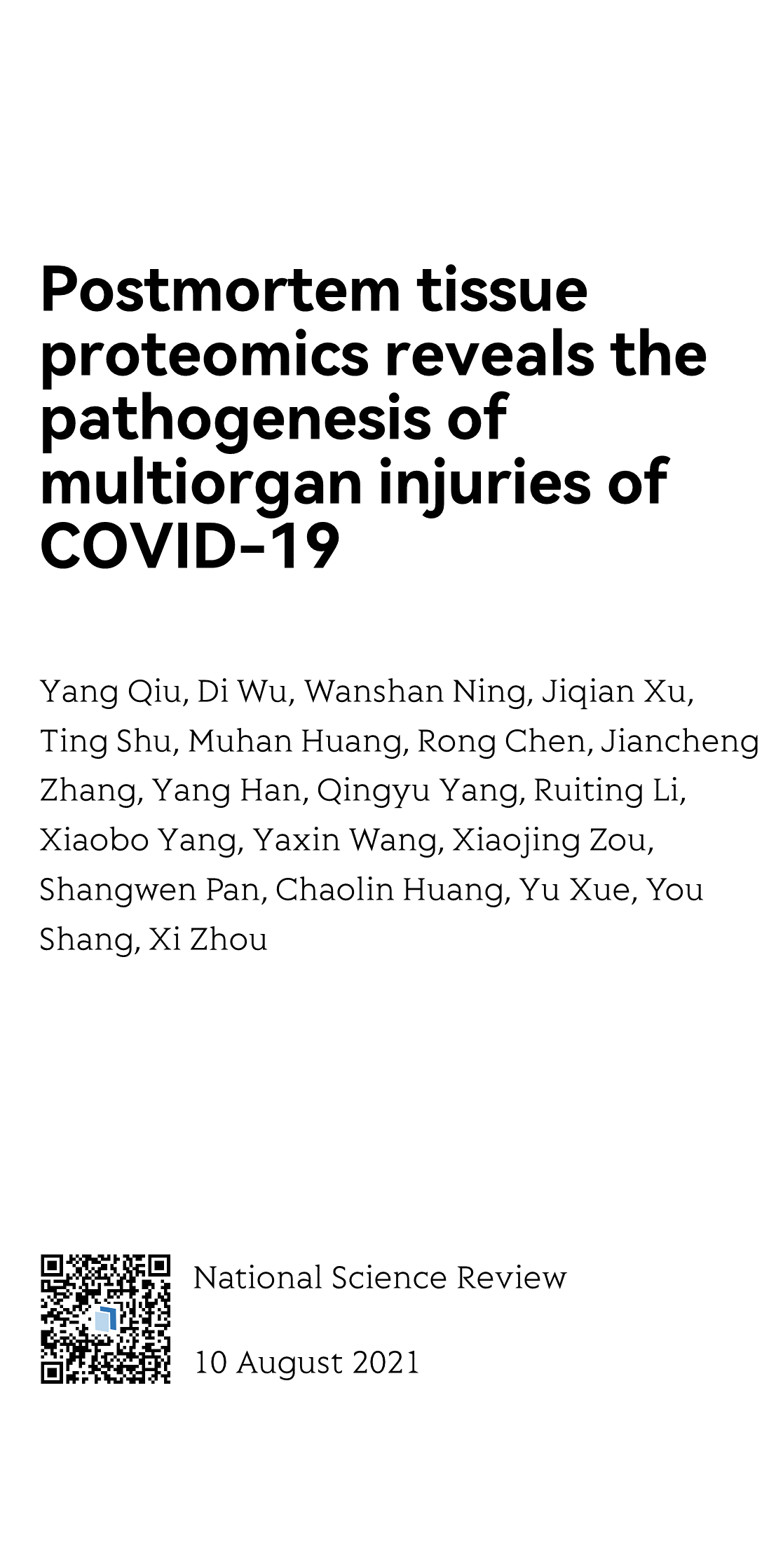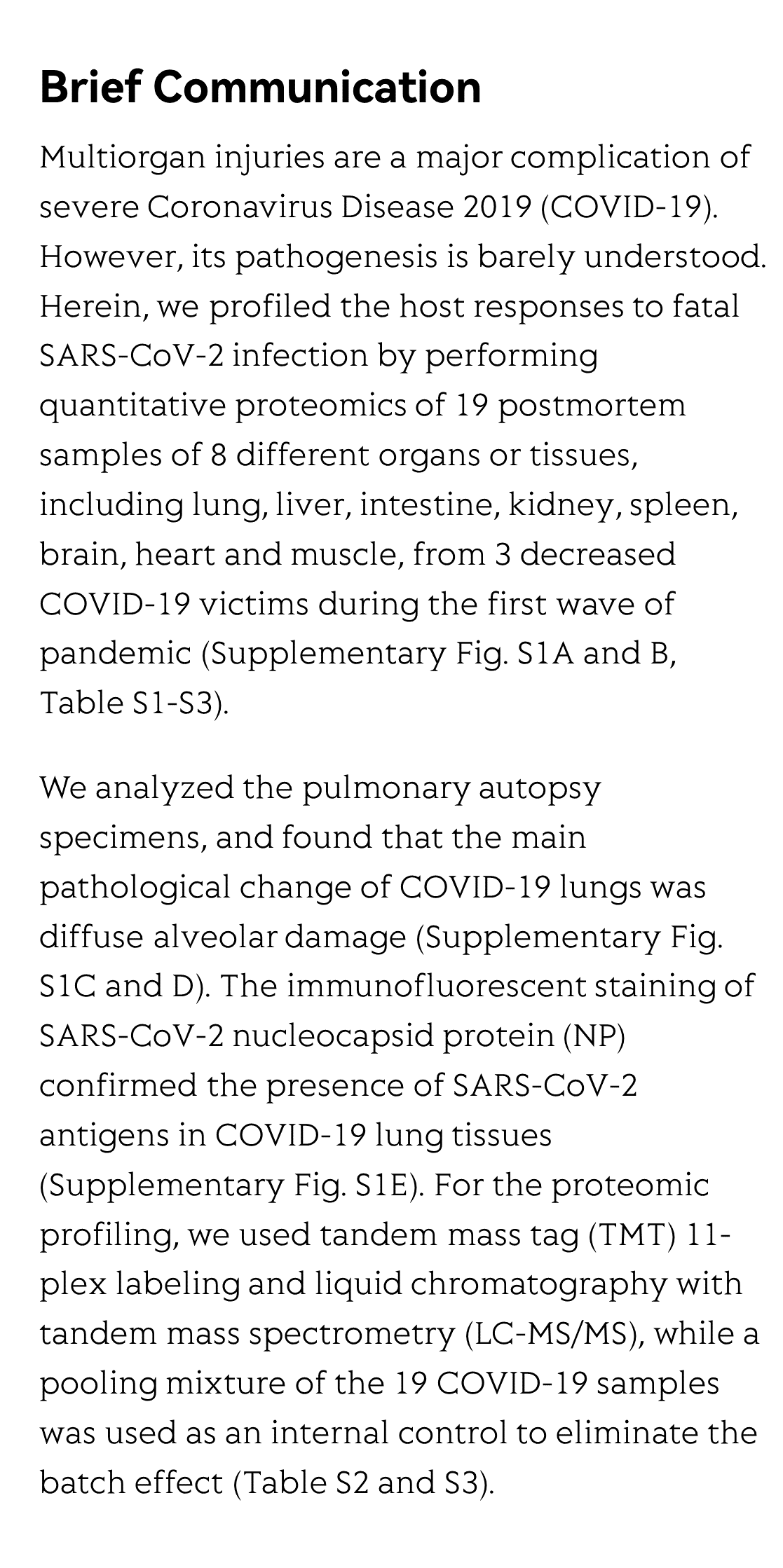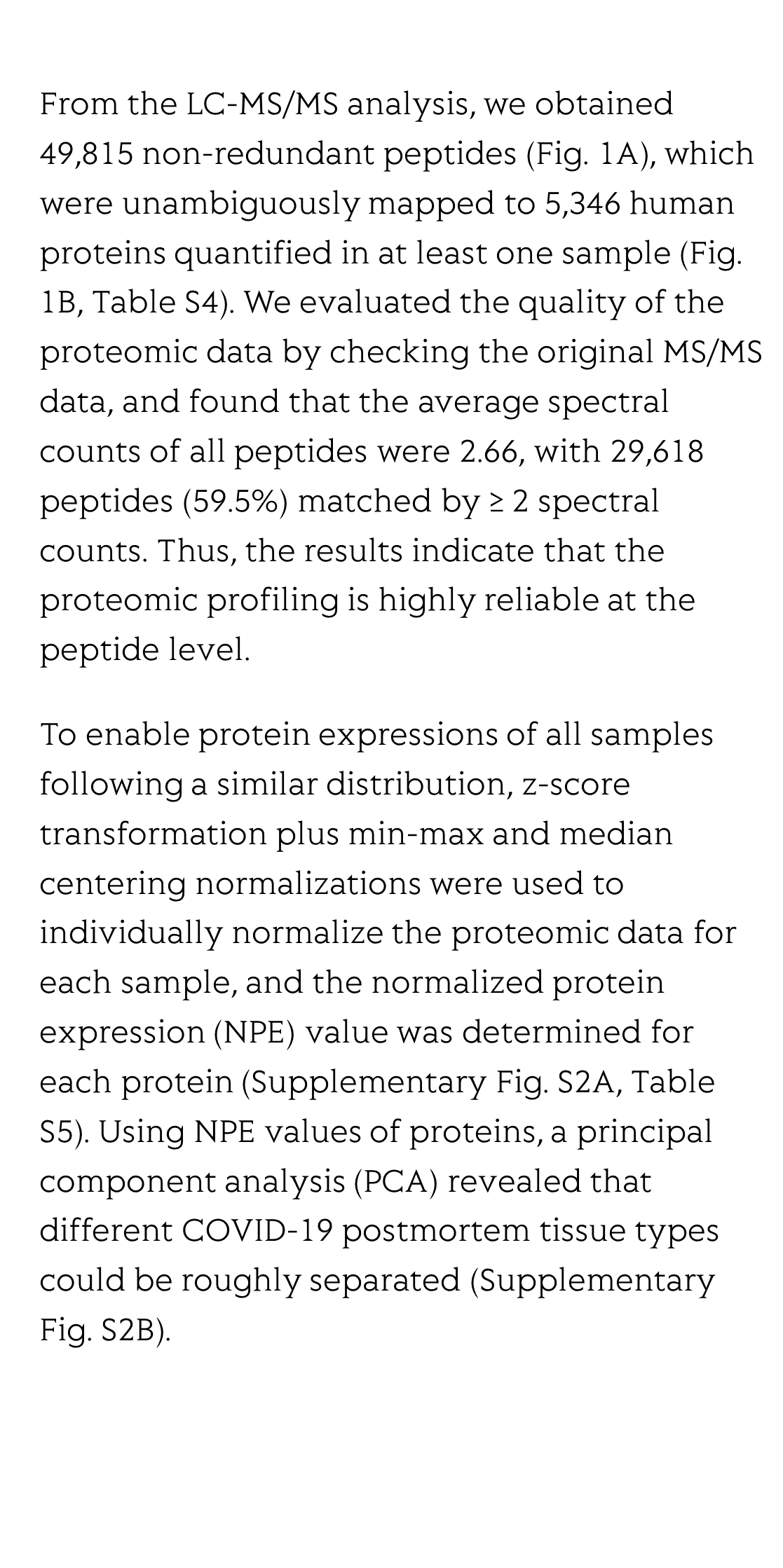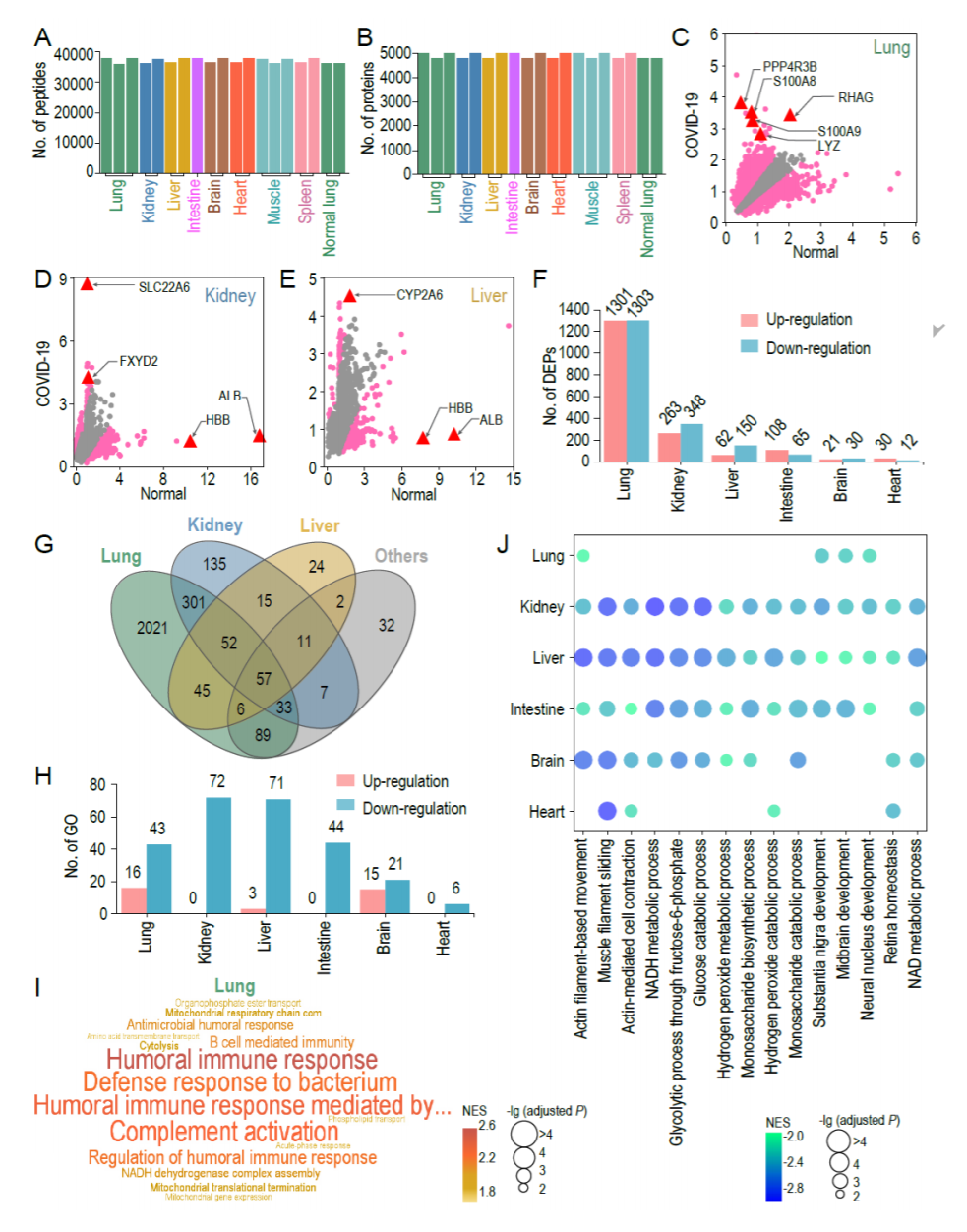(Peer-Reviewed) Postmortem tissue proteomics reveals the pathogenesis of multiorgan injuries of COVID-19
Yang Qiu 邱洋 ¹ ² ³, Di Wu 吴迪 ¹ ², Wanshan Ning 宁万山 ⁴ ⁵, Jiqian Xu 徐继前 ⁶, Ting Shu 舒婷 ² ³, Muhan Huang ¹ ², Rong Chen 陈蓉 ³, Jiancheng Zhang 张建成 ⁶, Yang Han 韩阳 ³ ⁷, Qingyu Yang ² ³ ⁷, Ruiting Li 李瑞婷 ⁶, Xiaobo Yang 杨小博 ⁶, Yaxin Wang 王雅鑫 ⁶, Xiaojing Zou 邹晓静 ⁶, Shangwen Pan 潘尚文 ⁶, Chaolin Huang 黄朝林 ³ ⁷, Yu Xue 薛宇 ⁴, You Shang 尚游 ⁶ ⁷ ⁸, Xi Zhou 周溪 ¹ ² ³
¹ State Key Laboratory of Virology, Wuhan Institute of Virology, Chinese Academy of Sciences, Wuhan, Hubei 430071, China 中国科学院 武汉病毒研究所 病毒学国家重点实验室
² Joint Laboratory of Infectious Diseases and Health, Wuhan Institute of Virology & Wuhan Jinyintan Hospital, Wuhan Institute of Virology, Chinese Academy of Sciences, Wuhan, Hubei 430023 China 武汉病毒研究所 武汉市金银潭医院 感染性疾病与健康联合实验室
³ Center for Translational Medicine, Wuhan Jinyintan Hospital, Wuhan, Hubei 430023 China 武汉市金银潭医院 转化医学中心
⁴ MOE Key Laboratory of Molecular Biophysics, Hubei Bioinformatics and Molecular Imaging Key Laboratory, Center for Artificial Intelligence Biology, College of Life Science and Technology, Huazhong University of Science and Technology, Wuhan, Hubei 430074, China 华中科技大学 生命科学与技术学院 人工智能生物学中心 生物信息与分子成像湖北省重点实验室 分子生物物理教育部重点实验室
⁵ Department of Clinical Laboratory, Union Hospital, Tongji Medical College, Huazhong University of Science and Technology, Wuhan, Hubei 430022, China 华中科技大学 同济医学院附属协和医院 检验科
⁶ Department of Critical Care Medicine, Union Hospital, Tongji Medical College, Huazhong University of Science and Technology, Wuhan, Hubei 430030 China 华中科技大学 同济医学院附属协和医院 重症医学科
⁷ Joint Laboratory of Infectious Diseases and Health, Wuhan Institute of Virology & Wuhan Jinyintan Hospital, Wuhan Jinyintan Hospital, Wuhan, Hubei 430023 China 武汉市金银潭医院 武汉病毒研究所 感染性疾病与健康联合实验室
⁸ Institute of Anesthesiology and Critical Care Medicine, Union Hospital, Tongji Medical College, Huazhong University of Science and Technology, Wuhan, Hubei 430030 China 华中科技大学 同济医学院附属协和医院 麻醉与危重病医学研究所
National Science Review, 2021-08-10
Brief Communication
Multiorgan injuries are a major complication of severe Coronavirus Disease 2019 (COVID-19). However, its pathogenesis is barely understood. Herein, we profiled the host responses to fatal SARS-CoV-2 infection by performing quantitative proteomics of 19 postmortem samples of 8 different organs or tissues, including lung, liver, intestine, kidney, spleen, brain, heart and muscle, from 3 decreased COVID-19 victims during the first wave of pandemic (Supplementary Fig. S1A and B, Table S1-S3).
We analyzed the pulmonary autopsy specimens, and found that the main pathological change of COVID-19 lungs was diffuse alveolar damage (Supplementary Fig. S1C and D). The immunofluorescent staining of SARS-CoV-2 nucleocapsid protein (NP) confirmed the presence of SARS-CoV-2 antigens in COVID-19 lung tissues (Supplementary Fig. S1E). For the proteomic profiling, we used tandem mass tag (TMT) 11-plex labeling and liquid chromatography with tandem mass spectrometry (LC-MS/MS), while a pooling mixture of the 19 COVID-19 samples was used as an internal control to eliminate the batch effect (Table S2 and S3).
From the LC-MS/MS analysis, we obtained 49,815 non-redundant peptides (Fig. 1A), which were unambiguously mapped to 5,346 human proteins quantified in at least one sample (Fig. 1B, Table S4). We evaluated the quality of the proteomic data by checking the original MS/MS data, and found that the average spectral counts of all peptides were 2.66, with 29,618 peptides (59.5%) matched by ≥ 2 spectral counts. Thus, the results indicate that the proteomic profiling is highly reliable at the peptide level.
To enable protein expressions of all samples following a similar distribution, z-score transformation plus min-max and median centering normalizations were used to individually normalize the proteomic data for each sample, and the normalized protein expression (NPE) value was determined for each protein (Supplementary Fig. S2A, Table S5). Using NPE values of proteins, a principal component analysis (PCA) revealed that different COVID-19 postmortem tissue types could be roughly separated (Supplementary Fig. S2B).
Flicker minimization in power-saving displays enabled by measurement of difference in flexoelectric coefficients and displacement-current in positive dielectric anisotropy liquid crystals
Junho Jung, HaYoung Jung, GyuRi Choi, HanByeol Park, Sun-Mi Park, Ki-Sun Kwon, Heui-Seok Jin, Dong-Jin Lee, Hoon Jeong, JeongKi Park, Byeong Koo Kim, Seung Hee Lee, MinSu Kim
Opto-Electronic Advances
2025-09-25
Dual-frequency angular-multiplexed fringe projection profilometry with deep learning: breaking hardware limits for ultra-high-speed 3D imaging
Wenwu Chen, Yifan Liu, Shijie Feng, Wei Yin, Jiaming Qian, Yixuan Li, Hang Zhang, Maciej Trusiak, Malgorzata Kujawinska, Qian Chen, Chao Zuo
Opto-Electronic Advances
2025-09-25







